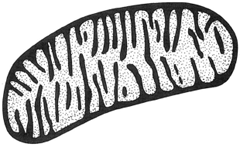Mitochondria
Mitochondria are minute organelles measuring approximately 1 by 3 microns. Mitochondria are said to be the “power houses” of the cell because many of the chemical changes associated with respiration take place in these structures. As glucose is broken down in respiration, energy is released. This energy goesi nto the manufacture of ATP (adenosine triphosphate). |
| Figure 2-6 A mitochondrion. The inner membrane of this double membraned structure has folds that extend into the interior of the organelle. This infolding increases the inner surface area. |
This breakdown is achieved stepwise, and while some of the steps occur in the cytoplasm, most of the changes occur in the mitochondria. A much larger amount of ATP is manufactured in the mitochondria, and the ATP that is made there is stored there. The mitochondria, then, contain the energy reserves that are called upon to do the work of the cell; thus the nickname “power houses.”
It is not the aim at this point to consider the chemistry of respiration but,rather, to consider the structure of the mitochondria. Whereas these structures are present in all eukaryotic cells, they are not present in prokaryotes. Structurally, they resemble chloroplasts in that they each possess a double membrane system: an outer smooth membrane and an inner, much convoluted membrane.
The outer membrane contains passageways. The inner membrane is impermeable. The inward projecting parts of the inner membrane are called cristae; in plants, they commonly appear as tubules. Many enzymes involved in the chemistry of respiration are aligned along these cristae. Every chemical change requires its own particular kind of enzyme, and the various enzymes appear to be arranged here in a proper sequencing. There are perhaps as many as seventy different kinds of enzymes in the mitochondria.
Given that mitochondria are associated with steps in respiration and energy harvesting, one might suppose that they would be found where the most energy is required. The cluster of mitochondria found at the bases of flagella appears to confirm this assumption. While not forgetting that our concern is botany, it is interesting to note that 500 times more mitochondria are found in heart muscle cells than are found in cells of other, less active muscles.
As already indicated, mitochondria from different kinds of cells, and even from different kinds of organisms, have quite similar structures: and, of course, they all perform the same functions.
As is true of chloroplasts, mitochondria have their own DNA, RNA (ribonucleic acid), and ribosomes. Further, both mitochondria and chloroplasts are self-replicating structures; that is, all mitochondria come from previously existing mitochondria, and all chloroplasts come from previously existing chloroplasts.
Mitochondria are, then, semi-autonomous. They are only partially dependent on nuclear genes. Professor Lynn Margulis postulates that their presence in cells is a consequence of invasion; that is, mitochondria came to be in cells by virtue of a prokaryotic cell crawling into another prokaryote and taking up residence there. The event is called endosymbiosis and is thought to have taken place approximately one and one-half billion years ago. The same is proposed regarding other organelles; Professor Margulis further suggests that the origin of mitochondria may be traced to purple bacteria entering a prokaryote in this manner.
Mitochondrial DNA replication and the division of mitochondria are not synchronized with nuclear division.




